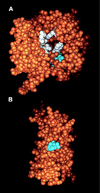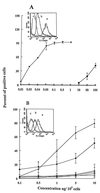Evidence for a structural motif in toxins and interleukin-2 that may be responsible for binding to endothelial cells and initiating vascular leak syndrome
- PMID: 10097145
- PMCID: PMC22402
- DOI: 10.1073/pnas.96.7.3957
Evidence for a structural motif in toxins and interleukin-2 that may be responsible for binding to endothelial cells and initiating vascular leak syndrome
Abstract
The dose-limiting toxicity of interleukin-2 (IL-2) and immunotoxin (IT) therapy in humans is vascular leak syndrome (VLS). VLS has a complex etiology involving damage to vascular endothelial cells (ECs), extravasation of fluids and proteins, interstitial edema, and organ failure. IL-2 and ITs prepared with the catalytic A chain of the plant toxin, ricin (RTA), and other toxins, damage human ECs in vitro and in vivo. Damage to ECs may initiate VLS; if this damage could be avoided without losing the efficacy of ITs or IL-2, larger doses could be administered. In this paper, we provide evidence that a three amino acid sequence motif, (x)D(y), in toxins and IL-2 damages ECs. Thus, when peptides from RTA or IL-2 containing this sequence motif are coupled to mouse IgG, they bind to and damage ECs both in vitro and, in the case of RTA, in vivo. In contrast, the same peptides with a deleted or mutated sequence do not. Furthermore, the peptide from RTA attached to mouse IgG can block the binding of intact RTA to ECs in vitro and vice versa. In addition, RTA, a fragment of Pseudomonas exotoxin A (PE38-lys), and fibronectin also block the binding of the mouse IgG-RTA peptide to ECs, suggesting that an (x)D(y) motif is exposed on all three molecules. Our results suggest that deletions or mutations in this sequence or the use of nondamaging blocking peptides may increase the therapeutic index of both IL-2, as well as ITs prepared with a variety of plant or bacterial toxins.
Figures





Similar articles
-
The effect of a monoclonal antibody coupled to ricin A chain-derived peptides on endothelial cells in vitro: insights into toxin-mediated vascular damage.Exp Cell Res. 2000 Aug 1;258(2):417-24. doi: 10.1006/excr.2000.4954. Exp Cell Res. 2000. PMID: 10896793
-
Immunotoxins containing Pseudomonas exotoxin that target LeY damage human endothelial cells in an antibody-specific mode: relevance to vascular leak syndrome.Clin Cancer Res. 1995 Dec;1(12):1589-94. Clin Cancer Res. 1995. PMID: 9815960
-
Generation of a potent chimeric toxin by replacement of domain III of Pseudomonas exotoxin with ricin A chain KDEL.Bioconjug Chem. 1995 Sep-Oct;6(5):624-9. doi: 10.1021/bc00035a018. Bioconjug Chem. 1995. PMID: 8974463
-
Why toxins!Semin Cancer Biol. 1996 Apr;7(2):87-95. doi: 10.1006/scbi.1996.0013. Semin Cancer Biol. 1996. PMID: 8740564 Review.
-
In vitro studies of ricin A-chain-induced vascular leak syndrome.Methods Mol Biol. 2001;166:125-35. doi: 10.1385/1-59259-114-0:125. Methods Mol Biol. 2001. PMID: 11217363 Review. No abstract available.
Cited by
-
Resveratrol prevents endothelial cells injury in high-dose interleukin-2 therapy against melanoma.PLoS One. 2012;7(4):e35650. doi: 10.1371/journal.pone.0035650. Epub 2012 Apr 20. PLoS One. 2012. PMID: 22532866 Free PMC article.
-
The role of interleukin-2 during homeostasis and activation of the immune system.Nat Rev Immunol. 2012 Feb 17;12(3):180-90. doi: 10.1038/nri3156. Nat Rev Immunol. 2012. PMID: 22343569 Review.
-
Cancer Drug Delivery Systems Using Bacterial Toxin Translocation Mechanisms.Bioengineering (Basel). 2023 Jul 7;10(7):813. doi: 10.3390/bioengineering10070813. Bioengineering (Basel). 2023. PMID: 37508840 Free PMC article. Review.
-
Potential therapeutic applications of plant toxin-ricin in cancer: challenges and advances.Tumour Biol. 2015 Nov;36(11):8239-46. doi: 10.1007/s13277-015-4028-4. Epub 2015 Sep 9. Tumour Biol. 2015. PMID: 26349746 Review.
-
Clinical targeting recombinant immunotoxins for cancer therapy.Onco Targets Ther. 2017 Jul 20;10:3645-3665. doi: 10.2147/OTT.S134584. eCollection 2017. Onco Targets Ther. 2017. PMID: 28790855 Free PMC article. Review.
References
-
- Vitetta E S, Thorpe P E, Uhr J W. Immunol Today. 1993;14:252–259. - PubMed
-
- Sausville E A, Vitetta E S. In: Monoclonal Antibody-Based Therapy of Cancer. Grossbard M L, editor. Vol. 4. Basel: Marcel Dekker; 1997. pp. 81–89.
-
- Baluna R, Vitetta E S. Immunopharmacology. 1996;37:117–132. - PubMed
-
- Engert A, Sausville E A, Vitetta E S. In: Clinical Applications of Immunotoxins. Frankel A E, editor. Vol. 2. Berlin: Springer; 1997. pp. 13–33.
-
- Dutcher J P, Gaynor E R, Boldt D H, Doroshow J H, Bar M H, Sznol M, Mier J, Sparano J, Fisher R I, Weiss G, et al. J Clin Oncol. 1991;9:641–648. - PubMed
MeSH terms
Substances
LinkOut - more resources
Full Text Sources
Other Literature Sources

